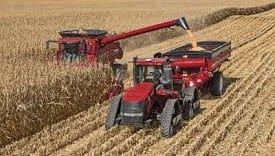by: R.L. (Bob) Nielsen, Purdue University
Corn is often harvested at grain moisture contents higher than the 15% moisture typically desired by grain buyers. Wetter grain obviously weighs more than drier grain and so grain buyers will “shrink” the weight of “wet” grain (greater than 15% moisture) to the equivalent weight of “dry” grain (15% moisture) and then divide that weight by 56 to calculate the market bushels of grain they will purchase from the grower. The two sources of weight loss due to mechanical drying are 1) that due to the loss of grain moisture itself and 2) the anticipated weight loss due to dry matter loss during the grain drying and handling processes (e.g., broken kernels, fines, foreign materials).
An exact value for the handling loss, sometimes called “invisible shrink”, is difficult to predict and can vary significantly from one grain buyer to another. For a lengthier discussion on grain weight shrinkage due to mechanical drying, see Hicks & Cloud, 1991.
The simple weight loss due to the removal of grain moisture represents the greatest percentage of the total grain weight shrinkage due to drying and is easily calculated using a handheld calculator or a smartphone calculator app. In general terms, you first convert the “wet” weight (greater than 15% moisture) to absolute dry weight (0% moisture). Then you convert the absolute dry weight back to market-standard “dry” weight at 15% grain moisture.
Concept:
- For example, if the initial grain moisture content is 20%, then the initial percent dry matter content is 80% (e.g., 100% – 20%). NOTE: The initial percent dry matter content varies depending on the initial grain moisture content.
- If the desired ending grain moisture content is 15% (the typical market standard), then the desired ending percent dry matter content is 85% (100% – 15%).
- Multiply the weight of the “wet” grain by the initial percent dry matter content, then divide the result by the desired ending percent dry matter content.
Example:
- 100000 lbs of grain at 20% moisture = 80000 lbs of absolute dry matter (i.e., 100000 x 0.80).
- 80000 lbs of absolute dry matter = 94118 lbs of grain at 15% moisture (i.e., 80000 / 0.85).
- 94118 lbs of grain at 15% moisture = 1681 bu of grain at 15% moisture (i.e., 94118 / 56).
One take-home reminder from this little exercise is the fact that the grain trade allows you to sell water in the form of grain moisture… up to a maximum market-standard 15% grain moisture content (or 14% for long term storage). In other words, if you deliver corn to the elevator at grain moisture contents less than 15%, you are “losing” bushels. Take advantage of this fact and maximize your “saleable” grain weight by delivering corn grain to the elevator at moisture levels no less than 15% moisture content.

